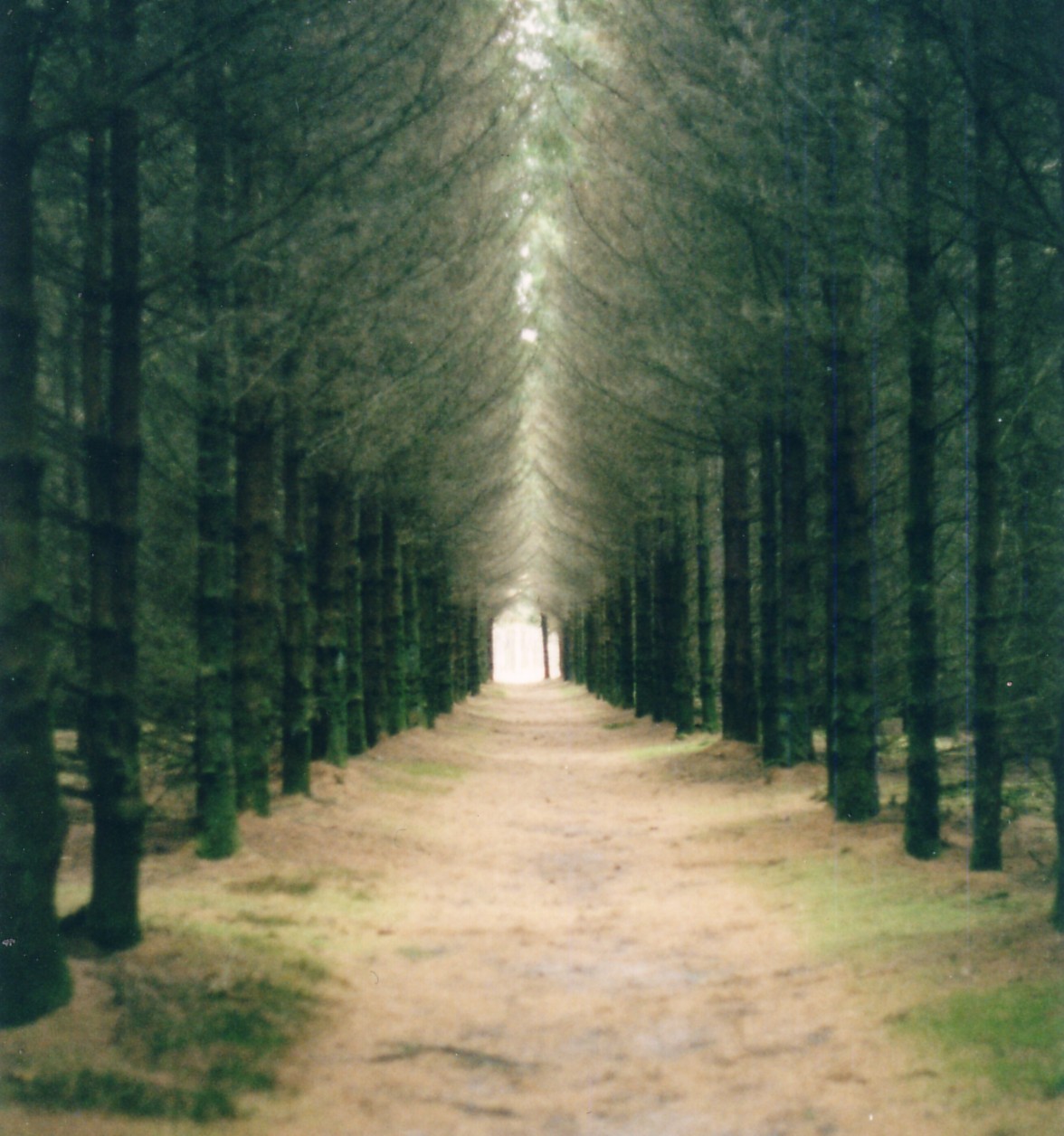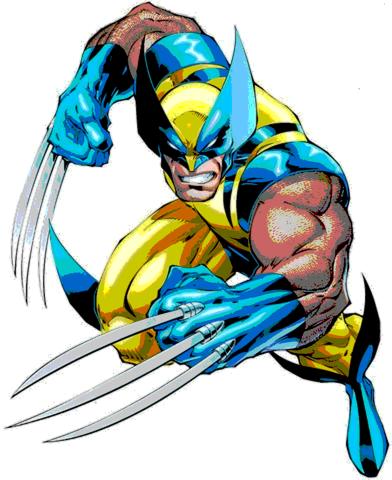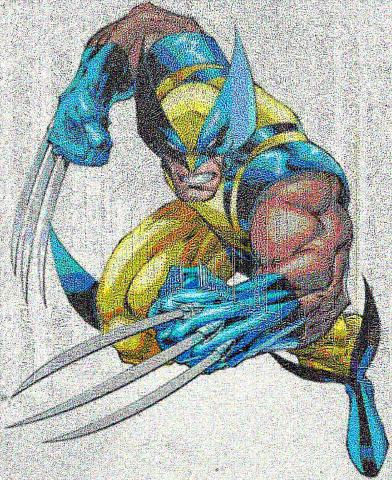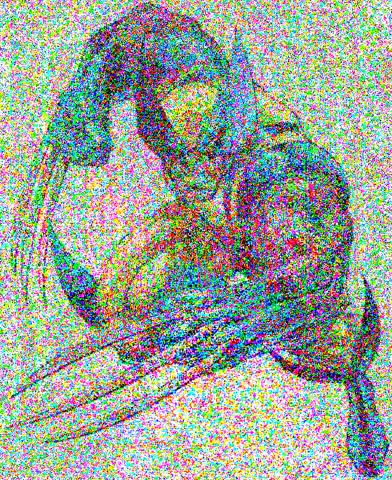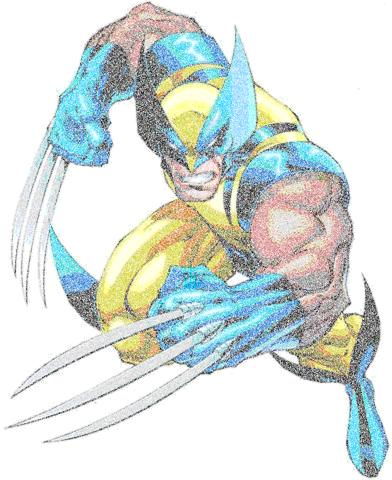% file name 'stegocombine.m'
% Run through Matlab
% By: Louis Casillas, oxaric@gmail.com
% Input:
% tree_path.jpg (RGB)
% wolverine.jpg (RGB)
% Output:
% displays these two images combined and the restored wolverine
% image pulled from the combined image
% How:
% resizes wolverine.jpg to the size of tree_path.jpg,
% adds the resized wolverine image to tree_path.jpg by weighted values
% specified by WEIGHTED_COMBINE_VALUE:
% combined_image = tree_path + (wolverine_resized * WEIGHTED_COMBINE_VALUE)
% then tries to restore the wolverine image by subtracting the original
% tree_path.jpg values from the combined_image values and dividing by
% WEIGHTED_COMBINE_VALUE:
% restored_wolverine_image = (tree_path - combined_image) / WEIGHTED_COMBINE_VALUE
% the percent used to multiply the wolverine.jpg color values by before
% adding them to tree_path.jpg
% 1.0 = 100%
WEIGHTED_COMBINE_VALUE = 0.01;
% false => only display combined image and restored image
% true => display all images
DISPLAY_INTERMEDIATE_IMAGES = false;
% set DISPLAY_TESTING_IMAGES to a number below to run those tests
% extra tests will show how the wolverine image is restored from the
% combined image for these 3 cases:
% 0 => no extra tests
% 1 => if the combined image is resized
% 2 => if the combined image is stored as a heavily compressed .jpg
% 3 => if the combined image has added noise
% 4 => show all tests
DISPLAY_TESTING_IMAGES = 4;
% load the images
original_tree_path_image = imread( 'tree_path.jpg' );
original_wolverine_image = imread( 'wolverine.jpg' );
% grab the x and y resolution for tree_path.jpg
tree_path_x_size = size( original_tree_path_image, 2 );
tree_path_y_size = size( original_tree_path_image, 1 );
% grab the x and y resolution for wolverine.jpg
original_wolverine_x_size = size( original_wolverine_image, 2 );
original_wolverine_y_size = size( original_wolverine_image, 1 );
if DISPLAY_INTERMEDIATE_IMAGES
% display the original tree_path.jpg
figure, imshow( original_tree_path_image ); title( 'Original - tree_path.jpg' );
% display the original wolverine.jpg
figure, imshow( original_wolverine_image ); title( 'Original - wolverine.jpg' );
end
% resize wolverine.jpg to be the same same as tree_path.jpg
resized_wolverine_image = imresize( original_wolverine_image, [tree_path_y_size, tree_path_x_size] );
if DISPLAY_INTERMEDIATE_IMAGES
% display the resized wolverine.jpg
figure, imshow( resized_wolverine_image ); title( 'Resized Wolverine' );
end
% create a blank image the same size as tree_path.jpg
% this will store the new image that is a combination of tree_path.jpg and
% wolverine.jpg
combined_image = zeros( tree_path_y_size, tree_path_x_size, 3 );
% add tree_path.jpg and wolverine.jpg but only give the pixels in
% the resized wolverine.jpg a weighted value determined by
% WEIGHTED_COMBINE_VALUE
for x_value = 1:tree_path_x_size
for y_value = 1:tree_path_y_size
combined_image( y_value, x_value, 1 ) = original_tree_path_image( y_value, x_value, 1 ) + (resized_wolverine_image( y_value, x_value, 1 ) * WEIGHTED_COMBINE_VALUE);
combined_image( y_value, x_value, 2 ) = original_tree_path_image( y_value, x_value, 2 ) + (resized_wolverine_image( y_value, x_value, 2 ) * WEIGHTED_COMBINE_VALUE);
combined_image( y_value, x_value, 3 ) = original_tree_path_image( y_value, x_value, 3 ) + (resized_wolverine_image( y_value, x_value, 3 ) * WEIGHTED_COMBINE_VALUE);
end
end
% force the combined image color values to be between 0 and 255
combined_image = uint8( combined_image );
% display the combined tree_path.jpg and wolverine.jpg
figure, imshow( combined_image ); title( 'Weight Combined Image' );
% create a blank image the same size as tree_path.jpg
wolverine_restored_big_image = zeros( tree_path_y_size, tree_path_x_size, 3 );
% take the values in the combined image and subtract them from the original
% tree_path.jpg values, this will give the values that were added to
% tree_path.jpg above, then divide these values by WEIGHTED_COMBINE_VALUE in order to try
% to get the original values in wolverine.jpg
for x_value = 1:tree_path_x_size
for y_value = 1:tree_path_y_size
wolverine_restored_big_image( y_value, x_value, 1 ) = ( combined_image( y_value, x_value, 1 ) - original_tree_path_image( y_value, x_value, 1 ) ) / WEIGHTED_COMBINE_VALUE;
wolverine_restored_big_image( y_value, x_value, 2 ) = ( combined_image( y_value, x_value, 2 ) - original_tree_path_image( y_value, x_value, 2 ) ) / WEIGHTED_COMBINE_VALUE;
wolverine_restored_big_image( y_value, x_value, 3 ) = ( combined_image( y_value, x_value, 3 ) - original_tree_path_image( y_value, x_value, 3 ) ) / WEIGHTED_COMBINE_VALUE;
end
end
% force wolverine restored image color values to be between 0 and 255
wolverine_restored_big_image = uint8( wolverine_restored_big_image );
if DISPLAY_INTERMEDIATE_IMAGES
% display the restored wolverine.jpg that is still the size of tree_path.jpg
figure, imshow( wolverine_restored_big_image ); title( 'Restored Wolverine - Tree Path Size' );
end
% resize wolverine_restored_big_image to the size of the original wolverine.jpg
wolverine_restored_image = imresize( wolverine_restored_big_image, [ original_wolverine_y_size , original_wolverine_x_size ] );
% display the restored wolverine image that is the original wolverine.jpg size
figure, imshow( wolverine_restored_image ); title( 'Restored Wolverine - Original Size' );
% compute the Peak Signal-to-Noise Ratio (PSNR) between the original
% wolverine.jpg and the wolverine image restored from the combined image
% The bigger the PSNR the closer the two images are to being exactly the
% same and if the PSNR is infinity the images are exactly the same
% If not infinity values of 30 to 50 are very good and values above 50 are
% excellent/amazing
% Displayed in the Matlab command window
mean_square_error = sum( sum( sum( ( original_wolverine_image - wolverine_restored_image ).^2 ) ) ) / double( original_wolverine_x_size * original_wolverine_y_size * 3 );
disp(' ')
disp('The PSNR between the original wolverine.jpg and the restored wolverine taken from the combined image:')
PSNR = 10 * log10( ( 255 )^2 / mean_square_error )
% DISPLAY_TESTING_IMAGES =
% 0 => no extra tests
% 1 => if the combined image is resized
% 2 => if the combined image is stored as a heavily compressed .jpg
% 3 => if the combined image has added noise
% 4 => show all tests
if (DISPLAY_TESTING_IMAGES ~= 0) && (DISPLAY_TESTING_IMAGES < 5)
% try to restore the wolverine image from the combined image when the
% combined image is resized
if (DISPLAY_TESTING_IMAGES == 1) || (DISPLAY_TESTING_IMAGES == 4)
% the percent to resize the combined image
PERCENT_TO_RESIZE = 0.4;
% resize the combined image
resized_combined_image = imresize( combined_image, [ tree_path_y_size * PERCENT_TO_RESIZE, tree_path_x_size * PERCENT_TO_RESIZE ] );
if DISPLAY_INTERMEDIATE_IMAGES
% display the resized combined image
figure, imshow( resized_combined_image ); title( 'Combine Image - Resized' );
end
% restore the resized combined image to its original size
restored_combined_image = imresize( resized_combined_image, [tree_path_y_size, tree_path_x_size ] );
if DISPLAY_INTERMEDIATE_IMAGES
% display the combined image that has been returned to its
% original size
figure, imshow( restored_combined_image ); title( 'Combined Image - Resized to Original Size' );
end
% try to get the original values in wolverine.jpg
for x_value = 1:tree_path_x_size
for y_value = 1:tree_path_y_size
wolverine_restored_big_image( y_value, x_value, 1 ) = ( restored_combined_image( y_value, x_value, 1 ) - original_tree_path_image( y_value, x_value, 1 ) ) / WEIGHTED_COMBINE_VALUE;
wolverine_restored_big_image( y_value, x_value, 2 ) = ( restored_combined_image( y_value, x_value, 2 ) - original_tree_path_image( y_value, x_value, 2 ) ) / WEIGHTED_COMBINE_VALUE;
wolverine_restored_big_image( y_value, x_value, 3 ) = ( restored_combined_image( y_value, x_value, 3 ) - original_tree_path_image( y_value, x_value, 3 ) ) / WEIGHTED_COMBINE_VALUE;
end
end
% force wolverine restored image color values to be between 0 and 255
wolverine_restored_big_image = uint8( wolverine_restored_big_image );
if DISPLAY_INTERMEDIATE_IMAGES
% display the restored wolverine.jpg that is still the size of tree_path.jpg
figure, imshow( wolverine_restored_big_image ); title( 'Restored Wolverine - Tree Path Size - Combined Image Resized' );
end
% resize wolverine_restored_big_image to the size of the original wolverine.jpg
wolverine_restored_image = imresize( wolverine_restored_big_image, [ original_wolverine_y_size , original_wolverine_x_size ] );
% display the restored wolverine image that is the original wolverine.jpg size
figure, imshow( wolverine_restored_image ); title( 'Restored Wolverine - Original Size - Combined Image Resized' );
% compute the Peak Signal-to-Noise Ratio (PSNR)
% Displayed in the Matlab command window
mean_square_error = sum( sum( sum( ( original_wolverine_image - wolverine_restored_image ).^2 ) ) ) / double( original_wolverine_x_size * original_wolverine_y_size * 3 );
disp(' ')
disp('The PSNR after resizing the combined image:')
PSNR = 10 * log10( ( 255 )^2 / mean_square_error )
end
% try to restore the wolverine image from the combined image when the
% combined image is made a heavily compressed .jpg
if (DISPLAY_TESTING_IMAGES == 2) || (DISPLAY_TESTING_IMAGES == 4)
% accepts values 0 to 100
% even if you specify 100 Matlab will compress the image to a minor
% degree, if you want absolutely no loss set PERCENT_OF_COMPRESSION
% to 100 and add this line to the inside of the imwrite function:
% , 'Mode', 'lossless'
PERCENT_OF_COMPRESSION = 50;
% uses Matlab to save the combined image as the compressed .jpg
% image 'compressed_combined.jpg'
imwrite( combined_image, 'combined_compressed.jpg', 'Quality', PERCENT_OF_COMPRESSION );
% reads in the compressed combined .jpg image
restored_combined_image = uint8( imread( 'combined_compressed.jpg' ) );
if DISPLAY_INTERMEDIATE_IMAGES
% display the compressed combined image .jpg image
figure, imshow( restored_combined_image ); title( 'Combined Image - After Saving As a Compressed .jpg' );
end
% try to get the original values in wolverine.jpg
for x_value = 1:tree_path_x_size
for y_value = 1:tree_path_y_size
wolverine_restored_big_image( y_value, x_value, 1 ) = ( restored_combined_image( y_value, x_value, 1 ) - original_tree_path_image( y_value, x_value, 1 ) ) / WEIGHTED_COMBINE_VALUE;
wolverine_restored_big_image( y_value, x_value, 2 ) = ( restored_combined_image( y_value, x_value, 2 ) - original_tree_path_image( y_value, x_value, 2 ) ) / WEIGHTED_COMBINE_VALUE;
wolverine_restored_big_image( y_value, x_value, 3 ) = ( restored_combined_image( y_value, x_value, 3 ) - original_tree_path_image( y_value, x_value, 3 ) ) / WEIGHTED_COMBINE_VALUE;
end
end
% force wolverine restored image color values to be between 0 and 255
wolverine_restored_big_image = uint8( wolverine_restored_big_image );
if DISPLAY_INTERMEDIATE_IMAGES
% display the restored wolverine.jpg that is still the size of tree_path.jpg
figure, imshow( wolverine_restored_big_image ); title( 'Restored Wolverine - Tree Path Size - Combined Image Saved As a Compressed .jpg' );
end
% resize wolverine_restored_big_image to the size of the original wolverine.jpg
wolverine_restored_image = imresize( wolverine_restored_big_image, [ original_wolverine_y_size , original_wolverine_x_size ] );
% display the restored wolverine image that is the original wolverine.jpg size
figure, imshow( wolverine_restored_image ); title( 'Restored Wolverine - Original Size - Combined Image Saved As a Compressed .jpg' );
% compute the Peak Signal-to-Noise Ratio (PSNR)
% Displayed in the Matlab command window
mean_square_error = sum( sum( sum( ( original_wolverine_image - wolverine_restored_image ).^2 ) ) ) / double( original_wolverine_x_size * original_wolverine_y_size * 3 );
disp(' ')
disp('The PSNR after compressing the combined image to a .jpg:')
PSNR = 10 * log10( ( 255 )^2 / mean_square_error )
end
% try to restore the wolverine image from the combined image when the
% combined image has random added noise
if (DISPLAY_TESTING_IMAGES == 3) || (DISPLAY_TESTING_IMAGES == 4)
% specifies the maximum noise value
MAX_NOISE_VALUE = 20;
% specifies the approximate amount of noise
% amount of noise = (1 / AMOUNT_OF_NOISE)%
% 0 means every pixel of the combined image will have added noise
% 1 means ~50% will have added noise, 2 means ~33%, 3 means ~25%, ....
AMOUNT_OF_NOISE = 3;
noise_image = uint8( zeros( tree_path_y_size, tree_path_x_size, 3 ) );
% create a random noise image
for x_value = 1:tree_path_x_size
for y_value = 1:tree_path_y_size
if round( rand() * AMOUNT_OF_NOISE ) == 0
noise_image( y_value, x_value, 1 ) = round( rand() * (MAX_NOISE_VALUE + 1) );
noise_image( y_value, x_value, 2 ) = round( rand() * (MAX_NOISE_VALUE + 1) );
noise_image( y_value, x_value, 3 ) = round( rand() * (MAX_NOISE_VALUE + 1) );
end
end
end
% add the noise image to the combined image
noise_added_combined_image = combined_image + noise_image;
if DISPLAY_INTERMEDIATE_IMAGES
noise_display_image = ones( tree_path_y_size, tree_path_x_size, 3 ) * 255;
% create a random noise image
for x_value = 1:tree_path_x_size
for y_value = 1:tree_path_y_size
if noise_image( y_value, x_value, 1 ) ~= 0
noise_display_image( y_value, x_value, 1 ) = noise_image( y_value, x_value, 1 );
end
if noise_image( y_value, x_value, 2 ) ~= 0
noise_display_image( y_value, x_value, 2 ) = noise_image( y_value, x_value, 2 );
end
if noise_image( y_value, x_value, 3 ) ~= 0
noise_display_image( y_value, x_value, 3 ) = noise_image( y_value, x_value, 3 );
end
end
end
% display the noise image
figure, imshow( uint8(noise_display_image) ); title( 'Noise to Add to Combined Image' );
% display the combined image with added noise
figure, imshow( restored_combined_image ); title( 'Combined Image - After Adding Noise' );
end
% try to get the original values in wolverine.jpg
for x_value = 1:tree_path_x_size
for y_value = 1:tree_path_y_size
wolverine_restored_big_image( y_value, x_value, 1 ) = ( noise_added_combined_image( y_value, x_value, 1 ) - original_tree_path_image( y_value, x_value, 1 ) ) / WEIGHTED_COMBINE_VALUE;
wolverine_restored_big_image( y_value, x_value, 2 ) = ( noise_added_combined_image( y_value, x_value, 2 ) - original_tree_path_image( y_value, x_value, 2 ) ) / WEIGHTED_COMBINE_VALUE;
wolverine_restored_big_image( y_value, x_value, 3 ) = ( noise_added_combined_image( y_value, x_value, 3 ) - original_tree_path_image( y_value, x_value, 3 ) ) / WEIGHTED_COMBINE_VALUE;
end
end
% force wolverine restored image color values to be between 0 and 255
wolverine_restored_big_image = uint8( wolverine_restored_big_image );
if DISPLAY_INTERMEDIATE_IMAGES
% display the restored wolverine.jpg that is still the size of tree_path.jpg
figure, imshow( wolverine_restored_big_image ); title( 'Restored Wolverine - Tree Path Size - Combined Image With Added Noise' );
end
% resize wolverine_restored_big_image to the size of the original wolverine.jpg
wolverine_restored_image = imresize( wolverine_restored_big_image, [ original_wolverine_y_size , original_wolverine_x_size ] );
% display the restored wolverine image that is the original wolverine.jpg size
figure, imshow( wolverine_restored_image ); title( 'Restored Wolverine - Original Size - Combined Image With Added Noise' );
% compute the Peak Signal-to-Noise Ratio (PSNR)
% Displayed in the Matlab command window
mean_square_error = sum( sum( sum( ( original_wolverine_image - wolverine_restored_image ).^2 ) ) ) / double( original_wolverine_x_size * original_wolverine_y_size * 3 );
disp(' ')
disp('The PSNR after adding random noise to the combined image:')
PSNR = 10 * log10( ( 255 )^2 / mean_square_error )
end
end
|
